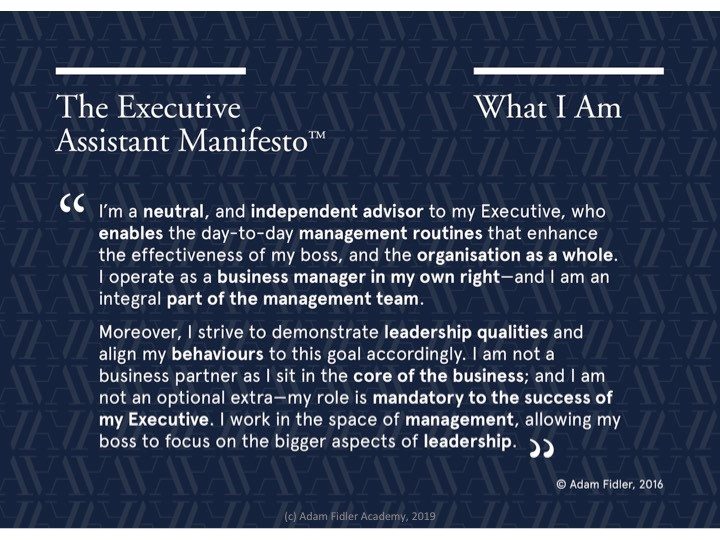PA Life asked Adam Fidler, who specialises in the education of EAs, to clarify what the difference between an EA and PA role is.
I have written extensively about the differences, and similarities, between the role of Personal Assistant (PA) and Executive Assistant (EA). This brief article will help current job-holders, as well as employers, define, more accurately, how the role of EA is different to more traditional forms of executive support, such as PA or even Executive Secretary. Having worked as a career EA for 20 years, in a variety of roles, including PA and EA, it was essential for me to demonstrate and evidence the value-added I could bring above and beyond traditional expectations. Here are a few key considerations.
1. An EA doesn’t just work for their exec
Firstly, and very importantly, the EA works ‘for the organisation’ not just ‘for the boss’ they support. PAs were, by default, required to provide a personal service – with all that entailed, and their role, if you will, was based on the preferences of their boss. So, a PA’s boss very much defined what precisely their PA did. This would include business work, as well as a huge emphasis on personal duties. Conversely, the EA’s role is based more on providing commercial support, that extends beyond just ‘servicing’ the boss or looking after them. This does not mean the EA “works” for everyone; far from it, but they have broader responsibilities to the organisation, as we will touch on shortly.
Crucially, the EA’s job does not change just because the boss changes; the role is defined with a number of responsibilities that are not at the bequest of the boss they are looking after. I call this ‘independence in the EA role’ and that’s something I have written widely about.
2. An EA supports strategic initiatives with broader responsibilities
Secondly, the EA has broader responsibilities than ‘admin’ and ‘support’ for their boss. This means they will be involved in a number of projects – company-wide or for their boss – and they add wider value by being involved in supporting the company’s strategic initiatives. Examples could be an EA who takes on the lead for wellbeing for their department; or the EA who is the Governance expert. Another example is the EA who is also a team leader or line manager. In the truest sense of the word, the EA is a ‘manager’ often without the title. They have more responsibility and accountability – often recognised by their status as a middle or senior manager.
3. An EA provides intellectual support
Thirdly, and mark my words carefully, an EA does not just provide mechanistic support (diaries, travel, POs) but also provide a level of intellectual support. By intellectual support we mean they lead and create things by reflective practice and thinking things through. They draft and write things; they research and come up with solutions and ideas. They initiate rather than wait to be told what to do, or even what to think. An Assistant who merely types an agenda is a PA; an Assistant who drafts and creates the agenda is an EA.
4. An EA is an integral part of the management team
Fourthly, the EA has a strategic mindset and operates accordingly. They think outside the box, aren’t afraid to challenge the status quo and have opinions. They align their ideas to their strong commercial awareness and work in partnership with their boss. They are an integral part of the management team and are afforded that status. In some instances, the EA, who has a sound commercial mind, may be the proxy or delegate for their boss. Sometimes it makes perfect sense for the EA to represent their boss, or lead the team meeting, rather than, for example, a Deputy CEO.
5. EAs commonly have dual titles and multiple responsibilities
Fifthly, the EA will take on a number of other hats and the dual-titled EA is now common-place. It is not uncommon for the true EA to be ‘EA to CEO and Project Manager’ or ‘EA to CEO and EA Team Leader’. We’re back to broader management responsibility. The EA’s scope should incorporate much less administrative support, and more managing and leading on specifics, such as operations management and projects.
This is merely a snapshot of some of the common themes and ideas we teach our EA students at my Academy to grasp and become competent at – and future proof their role as an EA. Simply, the EA is a manager and needs to develop strong management competencies to fulfil this brief.
For further information see ‘EA Manifesto: What I Am ™’
For the best summary of what an EA really is, see my ‘EA Manifesto: What I Am™’ which has now had over 2.5 million views worldwide. It defines the true EA without defaulting to using any stereotypical (nor secretarial) language. Read the words carefully for they define a managerial mindset, as well as the relevant managerial competencies. Many bosses, and EAs, agree that the EA Manifesto™ talks more scientifically about their role for maximum impact and influence.
Finally, remember: if you continue to define your role as a PA, that’s what you’ll be taken for. Getting the words right is an excellent starting point. But, PAs and EAs need to develop the right competencies too. Never “just a PA” but “always a manager” is what every EA must believe they are.
Adam Fidler is the founder of Adam Fidler Academy, which specialises in the education of EAs. The Academy’s programmes, such as The Strategic Executive Assistant™ have influenced the perception and definition of the EA role at home and abroad. To learn more, see: www.adamfilder.academy
Adam writes a regular column in PA Life. You may enjoy reading his spring 2023 column on How to take ownership of your Assistant career.











